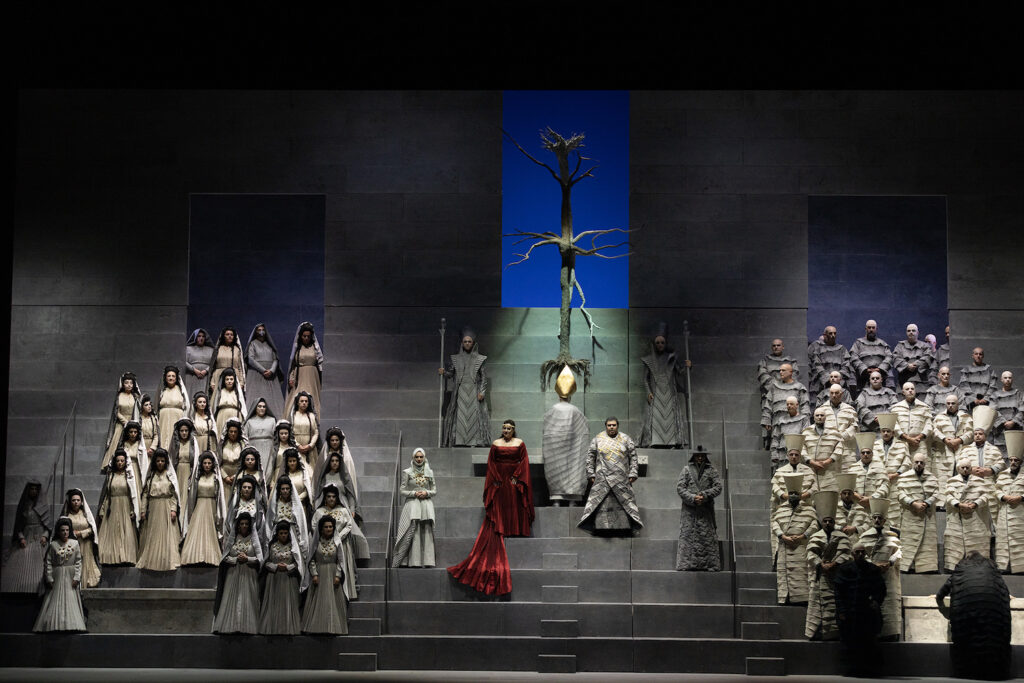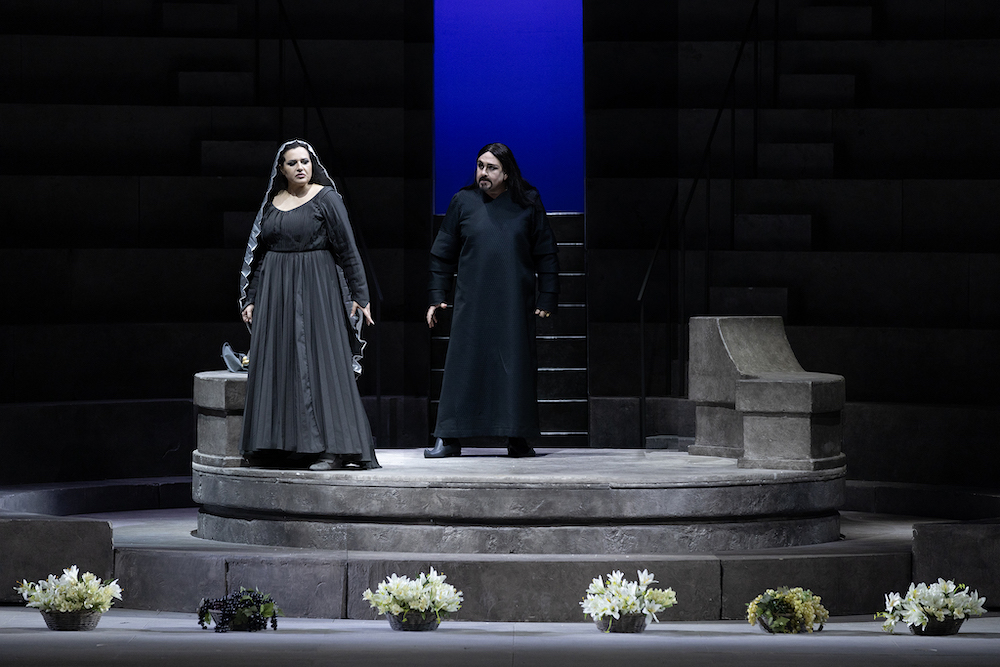Beyond its emerald waters, white sands and pecorino cheese, Sardinia is an opera destination! Just now it was Francesco Cilea’s fifth and last opera, Gloria, at the Teatro Lirico di Cagliari. This fine, late 20th century opera house is famed for its revivals of rare and forgotten operas.
Voilà Gloria, adding, possibly, an additional work to the very brief Cilea operatic canon — L’Arlesiana (1897) and Adriana Lecouvreur (1902). Gloria had its premiere at La Scala in 1907, the same year Strauss’ Salome first appeared at La Scala. Both works derive from the Parisian theater of the mid and late 19th century — think blood and thunder. Oscar Wilde’s French language play Salome premiered in Paris in 1893, Cilea’s opera Gloria derives from the Sardou 1874 play L’Haine (The Hate), his previous opera Adriana Lecouvreur was based on an 1849 Scribe play of the same name.
Scribe and Sardou are both famous as creators and purveyors of the science des planches (the planks of a theater stage), in other words the “well made play.” This means that they somehow fabricated sort-of plausible stories that always smoothly created opportunities for exaggerated emotional release (Tosca was a Sardou play, as an example).
Enter Edoardo Sonzogno and Gabriele D’Annunzio. Sonzogno, of the famed eponymous publishing house, instituted a famous one act opera competition won by Mascagni, thereby founding Italian operatic verismo. As well Sonzogno nourished the careers of other promising Italian composers. Cilea, rather than pursuing the emerging, strictly Italian verismo, looked oltre alpi — beyond the mountains that separate Italy from the rest of Europe — to the innovations of Debussy and Wagner, as well as to French theater, much as the poet/dramatist/fighter pilot D’Annunzio looked to enrich Italian letters and life with access to a larger, modern world.
Sonzogno recognized Cilea as a brilliant musician and supremely talented composer, a reputation that is well upheld by this Cagliari production. D’Annunzio, a major figure in Italian literature, loved the opera Adriana Lecouvreur, Cilea’s masterpiece. Cilea then sought D’Annunzio’s play Francesca da Rimini as the basis for his next opera. Verdi’s publisher Ricordi however owned the rights, extending them to Riccardo Zandonai whose resulting opera is now a part of the established international repertory.
Cilea’s substitute choice, Gloria, evokes all these intriguing and intricate histories of this fascinating, fecund moment in the history of opera. It also awakens, as performed just now in Cagliari, the deep regret that Cilea could not have rendered D’Annunzio’s play as an opera — after all there are three additional operatic versions of Adriana Lecouvreur.
Francesca da Rimini debuted in 1901 with the famed Italian actress Eleanora Duse (a Sarah Bernhardt rival as well as D’Annunzio’s mistress). Francesca and her lover Paolo. immortalized in Dante’s Divine Comedy, are murdered by Francesca’s ugly husband Gianciotto when he discovers them at a tryst, though it is a far more complicated tale.

When Arturo Colautti, Cilea’s librettist for both Adriana Lecouvreur and Gloria, renders Sardou’s Gloria into a well made opera, the plot becomes a bit similar to D’Annunzio’s play. Gloria, a maiden from Siena, is abducted by Lionetto, the scion of a rival family and political force. They fall in love, after a few bloody battles Lionetto seeks to reconcile the two families by his marriage to Gloria, but her brother Bardo avenges their fathers death by stabbing and killing Lionetto. Gloria then stabs herself and expires. Note that in the Sardou play the married lovers, victims of the plague, are entombed in a crypt where they quietly and poetically die, unlike the operatic punch of Colautti’s sudden murder and a subsequent suicide.
Note that the libretto is almost a duplicate of the Romeo and Juliet story as told by Bellini, whom Cilea greatly admired.
Thus Gloria herself arrives among the more imposing theatrical heroines, like Tosca, Eleanora Duse’s Francesca da Rimini, Sarah Bernhardt’s la dame aux camélias [i.e. La traviata], and of course the actress Adriana Lecouvreur. Librettist Colautti with his well made opera plot, and composer Cilea do not disappoint with two splendid arias for Gloria in the first act, a huge aria followed by a lovely prayer in the second act, and a heart breaking duet with Lionetto in the third act — all quite spellbinding in Cagliari.
Not to be outdone by Gloria, Lionetto has a quite extended aria in the first act, a ardent duet of declaration of love in the second act, the gut wrenching duet with Gloria in the third act, as well as fiery, heroic and dramatic encounters with absolutely everyone, including Gloria. Every opera demands a baritone, in Gloria it is her brother Bardo who has his share of glory in a first act aria, a huge and lively second act duet with his sister, and of course he caps the opera with the third act murder.
The Cilea sound is unique in its melodic sensuality, and its passion that often dissolves into rapture. It is harmonically sophisticated, and structurally highly complex, though remaining always tonal. It is greatly pleasurable and satisfying to the ear.
Clearly it is an opera in the Italian tradition, though with musical incursions from beyond the alps that result in thematic references that recall leitmotifs, and orchestral colors that resonate with natural phenomena, most notably the Act 1 activation of the fountain of peace, describing the waters as they begin to flow, as they mount, and then find a glorious climactic expulsion — it is orchestration that finds all of the not-so-hidden sexuality and extravagance of D’Annunzio’s prose and verse. Not to forget the descriptive musical extravagance of Cilea’s unseen battles.
Conductor Francesco Cilluffo made the most of Cilea’s colorful score, abetted by the willing orchestra of the Teatro Lirico di Cagliari.
Cherry atop the well-made-opera cake was the Act I finale, when all four protagonists (the pater familia Acquilante de’Bardi will be killed in an off stage battle) lined up across the front of the stage to share their individual thoughts with us, a quartet that rivals the famed fourth act Rigoletto quartet. Though here, in Cilea’s compositional extravagance, there is also the chorus of nobles, of the populace and finally of women alone bemoaning the fountain of peace having become a fountain of blood (Lionetto has stabbed Bardo).
Though musically magical, Cilea’s Gloria, as staged in Cagliari, was unable to rise above its genesis as an opera created according to formula.

The cast assembled by the Teatro Lirico di Cagliari well met the huge challenges of executing these monumental roles. I saw the fourth of eight performances when the announced Gloria, Anastasia Bartoli, was indisposed, thus the role was sung to fine effect by the Gloria of the alternate cast, Romanian soprano Valentina Boi. Stalwart Italian tenor Carlo Ventre was everything you need to be for Lionetto, I.e. heroically voiced. Bardo was sung by Franco Vassello, a baritone of considerable accomplishment who confidently voiced the vindictive brother. Georgian bass Ramaz Chikviladze sang Aquilante de’Bardii, his personage dispatched after the first act. The cameo role of a Sienese woman who encourages Gloria to succumb to Lionetto’s love was sung by Elena Schirru, a native Cagliarian.
The creators of the mise en scène, stage director Antonio Albanese, set designer Leila Fleet, and costume designer Carola Fenocchio mistook Cilea’s dramma lirico for a bona fide tragedy, choosing to place its acts in variations of a generic Greek theater and not in medieval Siena where there might have been an actual, monumental fountain. Costuming was highly abstract, Gloria’s wedding dress was in a remarkably spectacular, very red bird like form that bespoke blood, and the generous, indeed satisfying violence of the plot.
Michael Milenski
Teatro Lirico di Cagliari, Sardinia, February 15, 2023